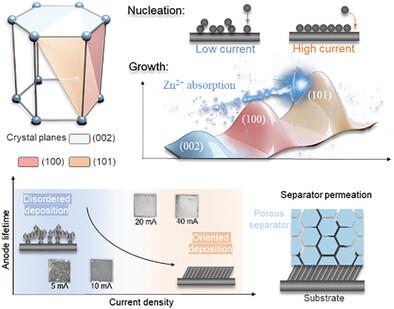当前位置:
X-MOL 学术
›
Adv. Mater.
›
论文详情
Our official English website, www.x-mol.net, welcomes your feedback! (Note: you will need to create a separate account there.)
Unraveling Paradoxical Effects of Large Current Density on Zn Deposition
Advanced Materials ( IF 29.4 ) Pub Date : 2024-04-23 , DOI: 10.1002/adma.202404140 Zhexuan Liu 1 , Jiachang Liu 1 , Xiao Xiao 1 , Zhiyang Zheng 1 , Xiongwei Zhong 2 , Qingjin Fu 1 , Shaogang Wang 3 , Guangmin Zhou 1
Advanced Materials ( IF 29.4 ) Pub Date : 2024-04-23 , DOI: 10.1002/adma.202404140 Zhexuan Liu 1 , Jiachang Liu 1 , Xiao Xiao 1 , Zhiyang Zheng 1 , Xiongwei Zhong 2 , Qingjin Fu 1 , Shaogang Wang 3 , Guangmin Zhou 1
Affiliation

|
Aqueous zinc-based batteries (ZBs) have been widely investigated owing to their intrinsic safety, low cost, and simple assembly. However, the actual behavior of Zn deposition under large current density is still a severe issue associated with obscure mechanism interpretation of ZBs under high loading. Here, differing from the conventional understanding that short circuit is induced by dendrite penetrating under large current density (10–100 mA cm−2), the separator permeation effect is unraveled to illustrate the paradox between smooth deposition and short lifespan. Generally, a dense plating morphology is achieved under large current density because of intensive nuclei and boosted plane growth. Nevertheless, in the scenes applying separators, the multiplied local current density derived from narrow separator channels leads to rapid Zn2+ exhaustion, converting the Zn deposition mode from nucleation control to concentration control, which eventually results in separator permeation and short circuit. This effect is validated in other aqueous metal anodes (Cu, Sn, Fe) and receives similar results. Based on the understanding, a micro-pore (150 µm) sponge foam is proposed as separators for large-current anodes to provide broader Zn2+ path and mitigate the separator permeation effect. This work provides unique perspectives on coordinating fast-charging ability and anode stability of ZBs.
中文翻译:

揭示大电流密度对锌沉积的矛盾影响
水系锌基电池(ZB)由于其本质安全、成本低廉和组装简单而受到广泛研究。然而,大电流密度下锌沉积的实际行为仍然是一个严重的问题,这与高负载下 ZB 的机制解释不明确有关。在这里,与传统的认为短路是在大电流密度(10-100 mA cm -2)下枝晶穿透引起的理解不同,隔膜渗透效应被揭示,以说明平滑沉积和短寿命之间的悖论。一般来说,由于密集的核和促进的平面生长,在大电流密度下可以获得致密的镀层形态。然而,在应用隔膜的场景中,狭窄的隔膜通道产生的局部电流密度成倍增加,导致Zn 2+快速耗尽,将Zn沉积模式从成核控制转变为浓度控制,最终导致隔膜渗透和短路。这种效应在其他水性金属阳极(铜、锡、铁)中得到了验证,并得到了类似的结果。基于此,建议采用微孔(150 µm)海绵泡沫作为大电流阳极的隔膜,以提供更宽的Zn 2+路径并减轻隔膜渗透效应。这项工作为协调 ZB 的快速充电能力和阳极稳定性提供了独特的视角。
更新日期:2024-04-23
中文翻译:

揭示大电流密度对锌沉积的矛盾影响
水系锌基电池(ZB)由于其本质安全、成本低廉和组装简单而受到广泛研究。然而,大电流密度下锌沉积的实际行为仍然是一个严重的问题,这与高负载下 ZB 的机制解释不明确有关。在这里,与传统的认为短路是在大电流密度(10-100 mA cm -2)下枝晶穿透引起的理解不同,隔膜渗透效应被揭示,以说明平滑沉积和短寿命之间的悖论。一般来说,由于密集的核和促进的平面生长,在大电流密度下可以获得致密的镀层形态。然而,在应用隔膜的场景中,狭窄的隔膜通道产生的局部电流密度成倍增加,导致Zn 2+快速耗尽,将Zn沉积模式从成核控制转变为浓度控制,最终导致隔膜渗透和短路。这种效应在其他水性金属阳极(铜、锡、铁)中得到了验证,并得到了类似的结果。基于此,建议采用微孔(150 µm)海绵泡沫作为大电流阳极的隔膜,以提供更宽的Zn 2+路径并减轻隔膜渗透效应。这项工作为协调 ZB 的快速充电能力和阳极稳定性提供了独特的视角。



























 京公网安备 11010802027423号
京公网安备 11010802027423号